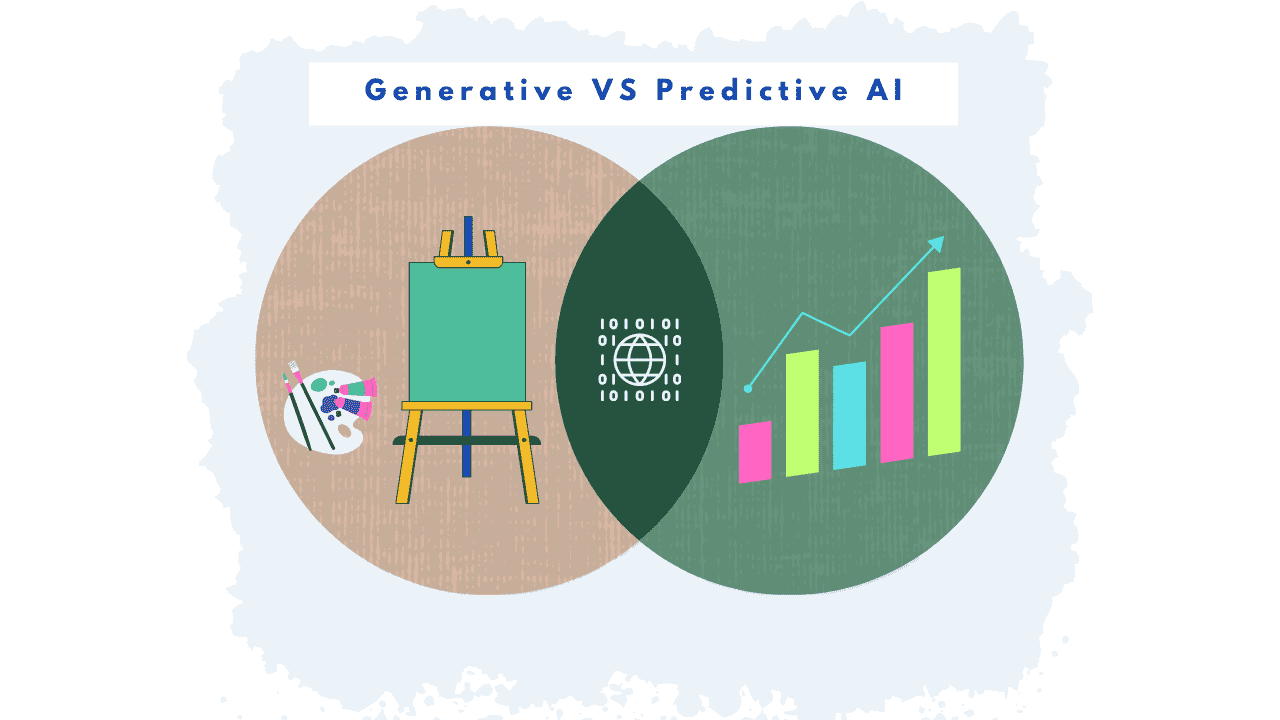Agentic AI Certification Training Course
- 4k Enrolled Learners
- Weekend/Weekday
- Live Class

In this article, we will take a closer look at two of the most talked about and widely used AI technologies of 2024 – generative AI and predictive AI.
While both involve machine learning and data analysis, they differ in their core objectives and approaches.
With generative AI such as ChatGPT, Gemini, Midjourney AI, and Dall-E, you can create (or to be more specific, generate) new content such as images, text, and code from scratch based on the patterns and relationships learned from training data.
Predictive AI, on the other hand, forecasts future events and outcomes, helping businesses to make data-driven decisions, optimize their day-to-day operations, and anticipate potential issues before they even occur!
Curious to learn more about the inner workings and latest breakthroughs of generative and predictive AI models? Well, put on your reading hat!
Short on time and even shorter on patience? No worries.
The table below provides a side-by-side comparison of generative AI vs predictive AI across various aspects, including their primary functions, core approaches, commonly used techniques, key applications, data inputs and outputs, evaluation metrics, and ethical concerns.
| Feature | Generative AI | Predictive AI |
| Function | Generate unique text, images, audio, code | Analyze historical data to identify patterns and make predictions |
| Underlying Techniques | Diffusion Models, Transformer Networks, Autoregressive Language Models | Machine Learning Algorithms, Deep Learning Models, Reinforcement Learning |
| Data Used for Training | Large datasets of existing creative content (e.g., paintings, songs, code) | Historical data relevant to the prediction task (e.g., sales figures, customer behavior, sensor readings) |
| Key Applications | Art and design, music composition, creative text formats (e.g., poems, code), drug discovery, material science | Finance (risk assessment, market trends), healthcare (early disease detection), retail (recommendation systems), manufacturing (predictive maintenance), supply chain management, weather forecasting |
| Evaluation Metrics | Quality, coherence, and creativity of generated outputs | Accuracy, precision, recall of predictions |
| Ethical Concerns | Copyright, deepfakes, biases, misuse for harmful content generation | Privacy, algorithmic bias, lack of transparency, unintended consequences |
| Level of Creativity | High – Creates original and unseen content | Low – Identifies patterns and trends in existing data |

While the uniqueness of the content generated by generative AI is a topic for another day, the speed at which it accomplishes so is unprecedented.
The quality of the output on any generative AI platform depends on how detailed and precise your input or prompts are. The key to generating a killer social media copy, catchy tune, or viral artwork using AI lies in a crystal clear, extremely specific set of prompts.
Unlike traditional AI systems that operate on pre-existing data, generative AI models learn the underlying patterns and relationships within their training data and use that knowledge to create novel outputs that did not previously exist.
Generative AI leverages the power of deep learning to build complex statistical models that process and mimic the structures present in different types of data.
These models are trained on vast datasets which allow them to identify intricate patterns and relationships that human eyes might overlook.
From a technical standpoint, generative AI models depend on various architectures and algorithms to achieve their remarkable creative capabilities. Some of the groundbreaking models at present include:
The basic idea behind these models is fairly straightforward – converting blurry noise into clear images through an iterative process known as diffusion. They learn to reverse this diffusion process during training which empowers them to generate high-quality images full of details and structure from text prompts or initial low-resolution images.
DALL-E and Stable Diffusion are popular examples in this category. Both are known for their ability to generate hyperrealistic images from text descriptions.
Transformer architectures, popularized by models like GPT-3 and BERT, use a self-attention mechanism to capture long-range dependencies within sequences.
In normal English, this mechanism helps generate coherent and contextually relevant text.
While GPT-3 can generate outputs in a wide array of creative text formats, like poems, code, or even scripts, BERT focuses more on understanding existing text but can be fine-tuned for generative tasks as well.
This type of model generates text one word at a time, predicting the most likely next word based on the previous words in the sequence. This allows for a more controlled and step-by-step text generation process.
Although computationally expensive, autoregressive models can achieve a much higher level of coherence and grammatical accuracy compared to their peers.
Key players in this segment include GPT-n Series (OpenAI), Jurassic-1 Jumbo, and Megatron-Turing NLG (NVIDIA). All of these AL LM models are known for generating immaculate output in different creative text formats while maintaining factual accuracy.
Generative technology has been in existence for quite sometime now but it didn’t become mainstream until the advent of Midjourney AI and ChatGPT. Today, generative AI is capable of accomplishing the following tasks:
Generative AI models like ChatGPT, Gemini, and Copy.ai can assist writers and content creators by creating “original” text. From snappy brand copies to witty social media captions as well as long-form narratives and scripts, the world is your oyster!
Models like DALL-E and Stable Diffusion can spawn highly realistic and imaginative images from simple text descriptions. These tools have been helping countless professionals as well as newbie designers and marketers, bring their vision to life.
Coders, both professionally trained and otherwise, are using AR LM models to generate functional code snippets and even entire programs. While not a legitimate substitute for expert coders, these tools can certainly act as powerful coding assistants to speed up the development process.
There’s no denying the fact that generative AI holds immense potential to revolutionize creative fields. However, the revolution is not without consequences. Below, we have outlined 5 key ethical concerns with generative AI:
Predictive AI, unlike its creative counterpart, is all about using data to peek into the future. Think of it as a super-powered fortune teller who analyzes humongous amounts of information to predict what might happen next. Its repertoire includes forecasting future events, market trends, and outcomes based on historical data and patterns.
Predictive AI thrives on data. The more historical data you feed it (e.g., sales figures, customer behavior, sensor readings), the better it can identify patterns and trends. Many advanced models are trained to analyze the emotional tone of text data such as emails, and social media posts.
The geek term for this process is sentiment analysis and marketers today heavily rely on this technology to predict customer satisfaction, gauge public opinion on a product launch, or even identify potential brand reputation issues.
Here’s a detailed breakdown of the core algorithms that power predictive AI:
These algorithms help identify patterns and make predictions based on structured data. Random Forests combine multiple decision trees to improve accuracy, while Gradient Boosting enhances weak models iteratively, making them highly effective for tasks like classification and regression.
Deep learning models are particularly adept at extracting insights from unstructured data like images, text, and audio.
Convolutional Neural Networks (CNN) are inspired by the way we see and are widely used for computer vision tasks, whereas Recurrent Neural Networks (RNN) are designed to handle sequential data, like text or financial data points over time.
CNNs are used for facial recognition in security systems as well as anomaly detection such as spotting defects in manufactured products.
RNNs, on the other hand, are ideal for tasks like language translation, sentiment analysis, and predicting future events (e.g., stock market trends).
This technique allows AI agents to learn optimal behaviors through trial and error, making it suitable for decision-making problems in dynamic environments. Reinforcement learning algorithms such as Q-Learning and Deep Q-Networks (DQNs) are extensively used in applications like robotics, gaming, and autonomous systems.
Ever wondered how your social media feed always shows relatable reels or suggests the exact kind of watch or jacket you have been looking for? The answer is predictive AI!
This same technology helps Spotify predict what you’d like to listen to and enables Netflix to suggest shows/movies you may like.
But how?
Predictive AI-based recommendation systems analyze your online behavior and preferences through past purchases, browsing history, and even clicks. Getting the picture?
This technology is also used to analyze massive amounts of transactional data to identify anomalies and patterns indicative offraudulent activities
. This empowers financial institutions and cybersecurity firms to ward off threats like credit card fraud, money laundering, and different forms of cyberattack.
The Internet of Things (IoT) has created a network of sensors that constantly monitor equipment performance. Predictive AI models can process this sensor data to predict potential failures before they take shape. Results? Reduced downtime, optimal resource allocation, and a significant reduction in repair costs.
As always, the power of AI comes with a responsibility to use it ethically. The ethical concerns of predictive AI include:
So, What’s Next?
What if the future of artificial intelligence is not Generative AI vs Predictive AI? What if there’s a way to get the best of both worlds?
By combining content generation and predictive analytics, businesses can create highly personalized experiences and offer recommendations based on individual preferences and behaviors. In healthcare, generative AI can assist in medical image analysis and report writing, while predictive models forecast patient outcomes. And that’s the tip of the iceberg of possibilities. You get the drift, don’t you?
At the end of the day, the common goal of both of these technologies is to drive innovation across industries and transform how we work, learn, and experience the world around us.
In this AI world, Understanding the characteristics of predictive AI and Generative AI is the first step in learning artificial intelligence. Generative AI activities like creating new content, texts, images, etc. Predictive AI focuses on future prediction based on the current data. If you are new to AI. Then, learn the basics of our AI for Beginners course. This course will help you to prepare for the advanced version of AI. Advance your career in AI with specialized AI agents training, focusing on building and deploying autonomous AI solutions.
Related Post: How to improve generative AI performance
 Thank you for registering Join Edureka Meetup community for 100+ Free Webinars each month JOIN MEETUP GROUP
Thank you for registering Join Edureka Meetup community for 100+ Free Webinars each month JOIN MEETUP GROUPedureka.co